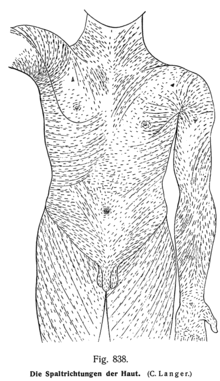Skin tension lines
Skin tension lines or Langer's lines , surgically also called split lines , indicate the direction of the least elasticity of the skin. They coincide with the course of the collagen fibers in the stratum reticulare of the dermis (dermis) and are generally parallel to the direction of the muscle fibers in the muscles below.
Skin incisions in the direction of the split lines gape less than cuts that run transversely to the direction of the split lines. For this reason, during surgical interventions, the incision is preferably made along the cleavage lines.
Knowing these lines is especially important in forensics and plastic surgery .
history
The different directions of the skin splitting were discovered in 1861 by the Austrian anatomist Karl Langer von Edenberg (1819–1887), who researched them in detail.
application
These lines are mainly used in skin surgery. Skin incisions should be made parallel to the skin tension lines in order to then close the wound edges with as little tension as possible and thus ensure the best possible healing. Knowledge of Langer's lines is particularly important in plastic and cosmetic surgery.
literature
Doris Henne-Bruns, Michael Dürig, Bernd Kremer. Surgery . Duale series, Thieme, 3rd edition, ISBN 978-3131252937
Individual evidence
- ↑ cleavage line. Doccheck.com, accessed August 25, 2018 .
- ↑ Karl Langer: To the anatomy and physiology of the skin. About the cleavage of the cutis. In: Report of the meeting of the mathematical and natural science class of the Vienna Imperial Academy of Sciences. Dept. 44, 1861.

